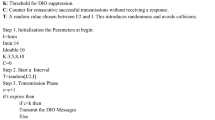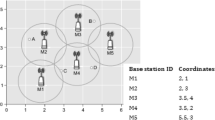Abstract
In IEEE 802.11 infrastructure wireless local area network (WLAN), the communication between any two nodes is relayed by an access point (AP), which becomes the bottleneck of WLAN and severely restricts the overall throughput. It is well known that network coding technique is able to greatly improve the throughput of wireless networks. But, the available coding schemes do not make full advantage of channel capacity due to the fact that they pick at most one packet from each data flow for coding and the picked packets may have a great difference in packet size, wasting some channel capacity. To remedy the problem, in this paper, we propose the coding scheme that combines multiple buffered packets in one flow into a larger packet for coding so that the packets participating in coding have close sizes. We formulate an integer programming problem to find the optimal packet coding, which is solved by an optimal algorithm with relative high time complexity together with a heuristic algorithm with relative low time complexity. Simulation results show that the proposed coding scheme is able to greatly improve the throughput of WLAN and the throughput gain increases with the growth of the number of coding flows.





Similar content being viewed by others
References
Ahlswede R, Cai N, Li S-YR, Yeung RW (2000) Network information flow. IEEE Trans Inf Theory 46(4):1204–1216
Wu Y, Chou PA, Kung S-Y (2005) Information exchange in wireless networks with network coding and physical-layer broadcast. In Proc. CISS
Ho T, Koetter R (2005) Online incremental network coding for multiple unicasts. DIMACS Working Group on Network Coding
Katti S, Rahul HS, Hu W, Katabi D, Médard M, Crowcroft J (2008) XORs in the air: practical wireless network coding. IEEE/ACM Trans Networking 16(3):497–510
Sengupta S, Rayanchu S, Banerjee S (2007) An analysis of wireless network coding for unicast sessions: the case for coding-aware routing. IEEE INFOCOM 1028–1036
Le J, Lui J, Chiu DM (2008) How many packets can we encode—an analysis of practical wireless network coding. In Proc. of IEEE INFOCOM 371–375
Zhao F, Medard M (2010) On analyzing and improving COPE performance. In Proc. of Information 1–6
Fang Z, Medard M, Hundeboll M, Ledet-Pedersen J, Rein S, Fitzek F (2012) Comparison of analytical and measured performance results on network coding in IEEE 802.11 ad-hoc networks, NetCod
Dong Q, Wu J, Hu W (2007) On the X-ities of network coding in wireless networks. In Proc. of International Conference on Measurement and Modeling of Computer Systems
Nage T, Yu FR, St-Hilaire M (2010) Adaptive control of packet overhead in XOR network coding. In Proc. of ICC 1–5
Kim Y, de Veciana G (2009) Is rate adaptation beneficial for inter-session network coding. IEEE Journal on Selected Areas in Communications 27(5):635–646
Kim T, Broustis I, Vural S, Syrivelis D, Singh S, Krishnamurthy S, La Porta T (2013) Realizing the benefits of wireless network coding in multirate settings. IEEE/ACM Trans Networking 21(3):950–962
Jones N, Shrader B, Modiano E (2012) Optimal routing and scheduling for a simple network coding scheme. IEEE INFOCOM
Zhang X, Neglia G, Kurose J, Towsley D, Wang H (2013) Benefits of network coding for unicast application in disruption-tolerant networks. IEEE/ACM Trans Networking 21(5):1407–1420
Chi K, Wu Y, Zhu Y, Leung VCM (2014) A network coding scheme to improve throughput for IEEE 802.11 WLAN. QSHINE 2014, Greece
Chi K, Jiang X, Horiguchi S (2010) Joint design of network coding and transmission rate selection for multihop wireless networks. IEEE Transactions on Vehicular Technology(TVT) 59(5):2435–2444
Internet packet size distributions: Some observations. http://netweb.usc.edu/rsinha/pkt-sizes/
Acknowledgments
This work was partially supported by the National Natural Science Foundation of China (Nos. 61472367, 61432015, and 61379124), the Ph.D. Programs Foundation of Ministry of Education of China (No. 20123317110002), the Natural Science Foundation of Zhejiang Province, China (No. LY13F020025), and the Project-sponsored by SRF for ROCS, SEM of China.
Author information
Authors and Affiliations
Corresponding author
Rights and permissions
About this article
Cite this article
Chi, K., Zhu, Yh., Wu, Y. et al. A Network Coding Scheme to Improve Throughput for IEEE 802.11 WLAN. Mobile Netw Appl 21, 425–435 (2016). https://doi.org/10.1007/s11036-015-0634-z
Published:
Issue Date:
DOI: https://doi.org/10.1007/s11036-015-0634-z




